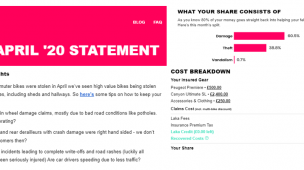Customer research doesn’t work
2 November, 2016 Greg Brown
In a recent post on building digital propositions we highlighted the importance of understanding customer needs. In this blog, we discuss how customer insight is best collected in the digital age.
The answer is to avoid traditional methods like focus groups and interviews. There is a huge disparity in emotional state between a ‘real customer’ and a ‘research customer’. One is being plied by nibbles, wine and a £50 note, and playing to an audience; the other has just remembered that they need to renew their car insurance at 10pm after a long day. It will be no surprise that what ‘research customer’ says often bears no relation to what he/she actually does. In the pre-digital age, researchers had to allow for this, but had few opportunities to collect ‘real customer’ data.
For digital propositions, this is no longer the case. Researchers – or, in a digital company, simply product managers going about their day-jobs – can collect immense amounts of information from ‘real customers’.
In this blog we describe four techniques to collect customer insight in the digital age.
-
Use data that describes ‘real customer’ behaviour
The vast amounts of data collected each day on the web allow researchers to see what people are actually doing.
Bought By Many, the UK personal lines distribution business, is a good example of this. They have built some software to compare Google search data and search results. They use this data to identify where there is an excess of demand over supply; for example, in 2015 they identified an opportunity to launch a bicycle liability insurance group (the first stage in their proposition to buying a policy).
In many instances good data sources may already exist for researchers. For example, Google has numerous databases, and providers of specific web data are too numerous to mention. Internal data may help too – but normally only when insurers and brokers are collecting behavioural data (as opposed to financial data) about their customers (see our blog on actionable metrics).
How to be successful: Look outside your organisation for helpful sources of behavioural data.
-
Observe competitors
They say ‘there’s nothing new under the sun’. Competitors tackling a similar problem can often be a good source of inspiration. What are they doing? How have they iterated their product? Does their social media feed suggest they are getting a good take up?
Where you can’t find precise matches then look outside of your sector and look at the constituent components of your proposition. For example, say you’re trying to launch a new online life insurance product, seek inspiration from companies in other sectors that are selling either complex or highly emotional products online.
And sometimes you can be creative. A highly successful entrepreneur in the greetings card business recently told us that he kept tabs of his main competitor by buying a card every month – he discovered that they issued invoices in sequence so this way he could compare his growth to theirs. And he changed his own invoicing numbering.
How to be successful: People love to share experiences (good and bad) so don’t be afraid to speak to other entre- or intrapreneurs directly (within the law…).
-
If you have to ask, start with problems not solutions
Customers are very bad at describing how they behave and imagining how they would actually respond to a proposition. They are, however, very good at describing the problems they face. If you are forced to go down the traditional route, it’s valuable to collect data on ‘needs’ rather than hypothetical behaviours.
There’s a famous example about this from focus groups: a retail group held a focus group where participants talked effusively about the product in question. At the end all of the participants were offered either the product for free or cash (less than the product cost). They all took the cash and the company learned everything it had to about the product.
How to be successful: Digital product managers talk about customer ‘needs’ and customer-product fits. Focus on the customer problem that you’re trying to solve rather than exploring hypothetical solutions.
-
Launch a real product
Research nirvana is to put a real product out into the market and see what customers think of it. In the digital world, this can be done much more quickly and easily than elsewhere.
We’ve been following the efforts of the Alternative Millennial Solutions division of Sanlam in South Africa. They are imminently launching a simple and fully mobile life insurance product from a standing start in an impressively short four months. As Peter Castleden, Head of the Alternative Millennial Solutions, said ‘Together with Sanlam’s digital team, we’ve built a sophisticated and secure mobile proposition for customers. However, given this is a completely new concept (24 hour cover with no restrictions, and immediate activation), we’ve really focused our efforts on the UX and usability. This allows us to test extremely quickly whether there is real appetite for the product, before investing in further development work’.
How to be successful: Reduce your full product vision down into what is called a ‘minimum viable product’ or ‘MVP’ in the startup world and use this to test your core assumptions about the product-market fit.
Conclusion
People often think that the ‘agility’ of startups means that entrepreneurs launch ideas with little understanding of where they are going but soon find the right product-market fit. This is not true: the best digital propositions are based on solid research and a detailed understanding of the target market. Where startups differ is in their use of ‘modern’ research methods to get this information.




